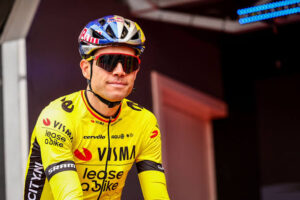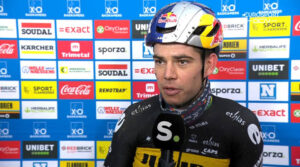Wout van Aert, one of the most dominant cyclists in the world, has been facing a challenging period as he recovers from a knee injury. The Belgian, known for his versatility across road cycling, cyclocross, and gravel events, has had to scale back his training and racing to ensure a full recovery, carefully managing his knee health. Though he’s been seen running and cycling again, his recovery process remains delicate, requiring constant attention and monitoring to avoid further damage.

Van Aert’s knee injury, which he sustained in the midst of an intense season, led to a temporary setback in his performances. Knee injuries are particularly problematic for cyclists, given the high demands placed on the joint during both high-intensity racing and long training sessions. In his case, the knee injury didn’t just affect his ability to race but also threatened to disrupt his ability to train, a critical part of maintaining peak form.
To aid his recovery, Van Aert has been carefully adjusting his training regimen. While cycling is his primary sport, the nature of the injury meant he could not immediately resume his usual training volume. Instead, he has focused on controlled and low-impact exercises, such as running, to maintain his cardiovascular fitness without aggravating the knee. Running, though a high-impact activity, can sometimes be easier on the knees in short, controlled doses. In these early stages of recovery, he has also incorporated exercises to strengthen the muscles around the knee and improve flexibility to alleviate strain on the joint.

However, despite being able to run and cycle again, Van Aert’s medical team has advised him to stay vigilant. Cycling, particularly during races, can subject the knee to repetitive stress and high forces, especially in the sprinting phases and on climbs. It’s this strain that can exacerbate the issue and potentially lead to more serious long-term problems if not carefully managed. Therefore, Wout has been keeping his focus on moderation—balancing high-intensity sessions with recovery time and limiting his participation in the most demanding events.
His recovery also involves a careful blend of physical therapy, rest, and medical supervision. The rehabilitation process aims not only to heal the knee but to ensure that it’s strengthened enough to support the rigorous demands of professional cycling. Physiotherapy plays a major role, helping him to gradually regain mobility and strength, as well as to reduce any inflammation that could delay the recovery process.
In recent months, Van Aert has also been open about the mental and emotional challenges of such a recovery. As an elite athlete used to competing at the highest levels, being sidelined by injury can be incredibly frustrating. Yet, the experience has reinforced his understanding of the importance of patience in healing. The mental aspect of recovery is just as crucial as the physical, and he’s shown resilience in taking the necessary steps to protect his future career.
With his eye on the longer-term picture, Van Aert has been slowly building his fitness back up. Though he has taken care not to rush his return to racing, he remains determined to get back to the top of his game, prepared for the upcoming season. Cycling fans around the world are eagerly awaiting his return, but more importantly, they’re rooting for his full recovery. Wout van Aert’s journey illustrates how recovery, resilience, and cautious optimism are essential for any athlete dealing with a serious injury, especially one as critical as a knee issue for a cyclist.








